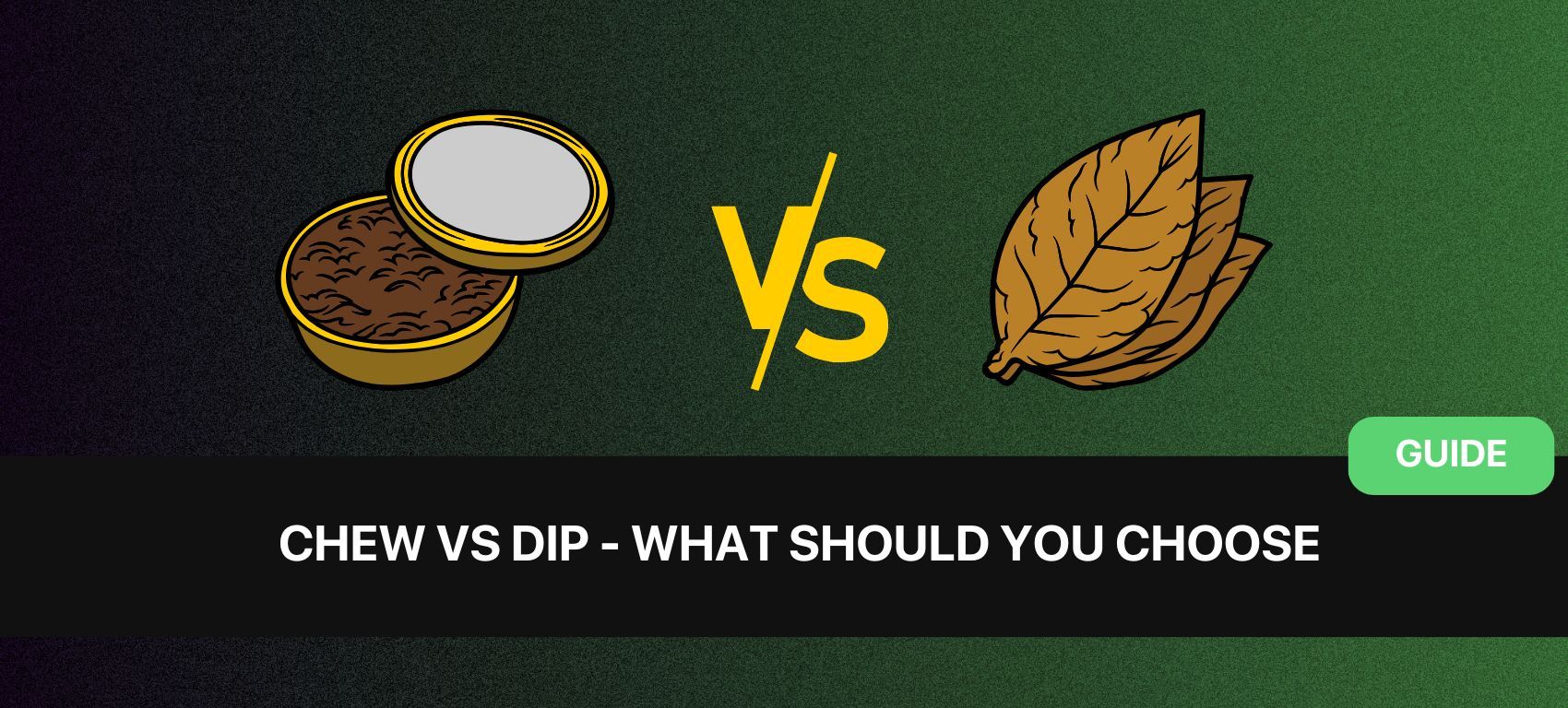Thinking about trying smokeless tobacco? Already dipping or chewing? Just looking for something that fits your routine better?
If you answered “YES” to any of the questions above, this guide is for you.
No matter where you stand, this breakdown will help you decide whether dip and chew is right for you. Heck, you may even discover safer alternatives like ZYN that are gaining traction among younger users and longtime tobacco fans alike!
Let’s get into it.
What Are Dip and Chew?
Dip is finely ground tobacco. You put it between your lower lip and gum. You don’t chew it. The nicotine kicks in fast, and you’ll need to spit.
Chew is made of bigger tobacco leaves. You place it in your mouth and slowly chew to release the flavor. It lasts longer and feels bulkier.

Both give you nicotine. Both involve spitting. But they look, feel, and work differently.
Now that we have a general idea about both, let’s compare them side by side.
Dip vs Chew: A Quick Comparison
Use the table below to see the key differences at a glance. This helps you choose the one that fits your style best.
|
Feature |
Dip |
Chew |
|
Tobacco Cut |
Fine and moist |
Thick and stringy |
|
How You Use It |
Place between the lip and the gum |
Chew slowly in your mouth |
|
Nicotine Kick |
Faster absorption |
Slower, more gradual |
|
How Long Does It Last |
Shorter sessions |
Longer-lasting use |
|
Packaging |
Tins or pouches |
Bags or bricks |
|
Flavor Options |
More variety (mint, citrus, etc.) |
Fewer flavors, mostly classic |
|
Feel in the Mouth |
Less bulky |
Thicker and heavier |
|
Spitting Required? |
Yes |
Yes |
Some people like the quick buzz of dip. Others prefer how long the chew lasts.
But hold on: before you decide which of the two you should use, let’s move to the most important facet of these smokeless tobacco products.
Health Risks: Dip vs Chew
Let’s get one thing straight:
Tobacco is tobacco.
Whether you dip or chew, you're putting your health at risk. These products may not involve smoke, but they can still cause serious harm, especially in your mouth.
Below is a graphic that illustrates the risk you’re putting your body into when using either one:

Here are studies supporting these findings to help you understand the science behind using them.
Cancer
According to the CDC, it causes cancers of the mouth, esophagus, and pancreas.
A 2024 meta-analysis also found that users had a 1.17x higher overall cancer risk and a 1.38x higher risk of cancer death.
Another global study reported that 1 in 3 oral cancer cases can be traced to smokeless tobacco use.
As you can see, this risk isn’t random. Products like dip and chew contain over 28 cancer-causing chemicals, according to the World Health Organization.
They include tobacco-specific nitrosamines (TSNAs), some of the most dangerous carcinogens in tobacco.
Gum and Tooth Damage
The ADA warns that dip and chew lead to tooth decay, gum disease, and tooth loss.
A study in ScienceDirect also shows 12.5% to 39.4% of users develop leukoplakia, white patches in the mouth that can turn cancerous.
Finally, A 2021 study also found that gum recession and bone loss were most severe where users placed their tobacco, especially in the lower front teeth.
Once gums recede, they don’t grow back. The longer you use it, the more damage you risk.
Nicotine Addiction
Dip and chew may not be lit, but they still deliver a heavy dose of nicotine.
According to Smokefree.gov, using just two cans of dip per week gives your body as much nicotine as 3.5 packs of cigarettes per day.
If you're wondering whether nicotine pouches are a safer option, here's what you need to know about whether Zyn pouches are safe to use and how they affect your gums.
Cost and Lifestyle Considerations
Health risks aren’t the only thing to think about.
Dip and chew also come with a financial cost and can impact your daily routine more than you might expect.
How Much Do They Cost?
A can of dip usually costs around $3 to $5, while a pouch of chew runs about $2 to $4.
That might not sound like much, but regular users can go through a can or more a day. That adds up to over $1,000 per year.
Want to see how your use compares? Check out how many nicotine pouches a day is too much.
Daily Use and Convenience
Dip is often seen as more discreet, but it still requires spitting. Chew takes up more space in your mouth and creates bulky waste.
Both can:
- Leave a strong smell
- Stain your teeth
- Make your breath unpleasant
- Require frequent clean-up
Also wondering about travel convenience? Here’s a guide to bringing nicotine pouches on a plane.
Alternatives to Traditional Dip and Chew
Despite their differences, dip and chew share similarities but for the wrong reasons.
This is why many users are looking for healthier options that offer the same feel or nicotine hit without all the risks.
Below are two of the more popular options you ought to consider:
Nicotine Pouches
Products like ZYN offer a tobacco-free option. They still contain nicotine but don’t have the same harmful chemicals found in dip or chew.
These pouches are also:
- Smoke-free
- Spit-free
- Easier to use discreetly
Learn more about Zyn alternatives or explore the best nicotine-free pouches.
Here are the top-two nicotine free pouches we recommend.
Herbal and Non-Tobacco Chews
Some products are made with tea leaves, mint, or other herbs that mimic the feel of chew but without nicotine or tobacco.
They help with the oral habit while avoiding addiction. But check the label. Some still have sweeteners or additives.
Conclusion: Making an Informed Choice
They may have similarities, but dip and chew are not the same.
To recap:
- Dip hits fast and feels lighter
- Chew lasts longer but feels bulkier
- Both come with serious health risks and high costs
- Alternatives like nicotine pouches may offer a cleaner option
P.S. Thinking about quitting? Here’s help:
You don’t have to decide right now. But now that you know the facts, you can make a better choice for yourself.
Chew vs Dip FAQs
Do chew and dip stain teeth differently?
Chew and dip stain teeth differently due to texture and placement. Dip sits against the gums and causes localized staining, while chew moves around the mouth, causing broader discoloration. Both can lead to brown stains and gum recession.
Which between chew and dip is easier for beginners to use?
Dip is generally easier for beginners to use than chew. Dip is pre-packaged, requires no spitting large pieces, and provides faster nicotine delivery, while chew demands constant jaw movement and spitting.
Can you switch from chew to dip without withdrawal?
You can switch from chew to dip without withdrawal if nicotine levels are matched. Withdrawal risk increases if dip provides less nicotine than chew, or if usage patterns change suddenly.
How do chew and dip compare in tobacco content?
Chew usually contains more tobacco by volume than dip. Dip delivers nicotine more efficiently due to finer grind and gum absorption, while chew has bulkier portions with slower release.



